Physical Address
304 North Cardinal St.
Dorchester Center, MA 02124
A benign proliferation in the superficial dermis, composed of fibroblasts, blood vessels, and sparse inflammatory cell infiltrate in the background of a sclerotic dermal collagen
Multiple lesions can be associated with tuberous sclerosis and, less commonly, with Birt–Hogg–Dube syndrome
Similar lesions on the penis have been designated as pearly penile papules
Solitary lesions most common in middle-aged adults
Multiple lesions in patients with tuberous sclerosis can be present at birth, but usually develop during childhood and are seen in about 90% of adult patients
Equal sex distribution
Solitary small, skin-colored, dome-shaped papule, rarely pedunculated
Predilection for the nose and face
Size from 1 to 5 mm
Multiple lesions associated with tuberous sclerosis (referred to as adenoma sebaceum ) typically develop over the nose and cheeks in a “butterfly” pattern, with bilateral and symmetrical, periungual proliferations known as Koenen tumors
No treatment generally required
Simple excision curative
Well-circumscribed proliferation in the superficial dermis composed of
Plump, spindle-shaped, stellate and/or multinucleated cell fibroblasts
Vascular channels, frequently dilated
Sparse inflammatory cell infiltrate, mainly composed of lymphocytes
Sclerotic dermal collagen in the background
Mitoses of spindle cells exceptional
Focal nuclear hyperchromatism of spindle cells can be seen
Additional features include
Perivascular and periadnexal fibrosis
Scattered vellus hairs
Lentiginous proliferation of melanocytes above the dermal lesion
Epidermis with hyperkeratosis, acanthosis, and flattened rete ridges pattern
Histological variants
Clear cell
Hypercellular
Marked proliferation of fibroblasts in comparison to classical fibrous papule
Pigmented
Hyperplasia of melanocytes, can be prominent
Dermal melanophages
Pleomorphic
Bizarre-shaped fibroblasts in the papillary dermis
Granular cell
Inflammatory
Predominance of inflammatory cells
Admixture of lymphocytes, plasma cells, and histiocytes
Eosinophilic and neutrophilic granulocytes rare
Epithelioid
Large cells, forming sheets and nests
Medium-sized centrally or peripherally located nuclei with prominent nucleoli
Prominent pink cytoplasm
Factor XIIIa positive, may also be CD34 positive
Clear cell variant can be NKIC3 and CD68 positive
Epithelioid cell variant diffusely procollagen positive, scattered CD68 positivity (70%), factor XIIIa negative
Consistently negative for cytokeratins, EMA, and S100 protein
Melanocytic lesions (intradermal melanocytic nevus, Spitz nevus, lentigo maligna, balloon cell nevus)
Epithelioid cell fibrous histiocytoma
Pleomorphic fibroma
Granular cell tumor
Dermal nonneural granular cell tumor
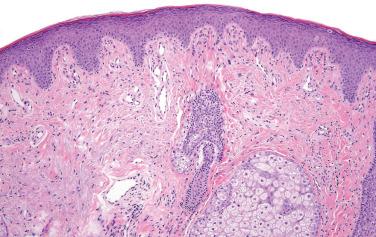
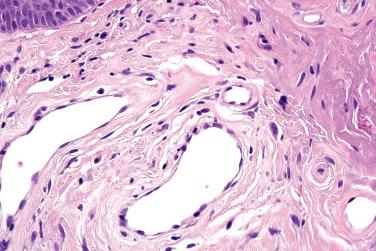
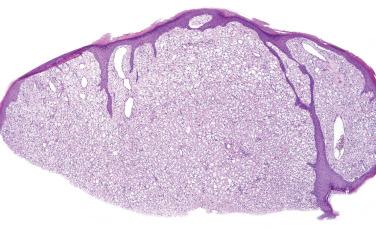
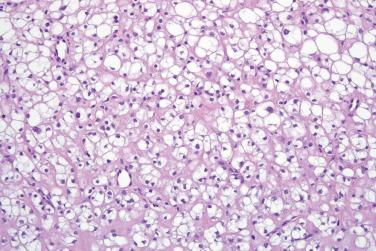
A distinctive benign dermal proliferation composed of thin-walled capillaries and veins, admixed with scattered multinucleated cells
Female predominance (F:M = 3 : 1)
Middle-aged adult patients
Slowly growing single or multiple firm, red-brown to violaceous papules
Multiple lesions usually distributed over the same area, occasionally bilateral
Surface is usually smooth, occasionally scaly
Size less than 1 cm in diameter
Most common over distal extremities, particularly dorsum of hands, wrists, thighs, and legs, with less frequent involvement of the face and trunk
Mucosal sites distinctly uncommon (oral cavity)
Usually asymptomatic, pruritic lesions rare
Clinical variants
Linear
Eruptive
Plaque-like
Disseminated/generalized
Spontaneous regression possible, but rare
Association with mycosis fungoides, diabetes mellitus, or vitiligo most likely coincidental
Vascular proliferation, composed predominantly of thin-walled capillaries and veins
Lumina dilated or narrow
Lined by a single layer of bland endothelial cells
Each vessel surrounded by layer of pericytes
Scattered multinucleated cells
Bizarre shaped
Hyperchromatic nuclei
Angulated cytoplasm
Fibroblast-like and histiocyte-like mononuclear cells
Thickened collagen bundles, frequently hyalinized
Occasional inflammatory cells, predominantly lymphocytes
Hemorrhage absent, no hemosiderin deposition
Decreased elastic fibers in the dermis can be observed
Overlying epidermis normal, but can also be hyperplastic
Proliferation restricted to upper and middermis
Multinucleated cells display variable CD68 positivity
Vascular markers delineate endothelial cells
Atrophic dermatofibroma
Microvenular hemangioma
Angiofibroma
Kaposi sarcoma
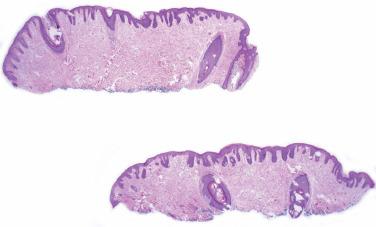
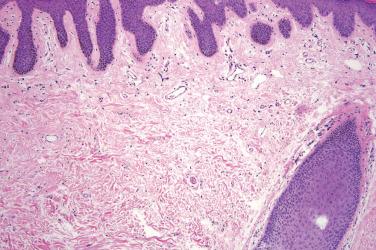
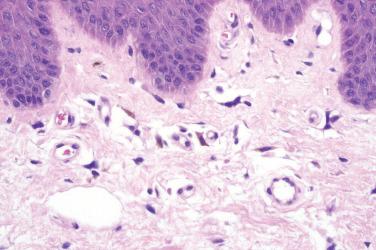
Neoplastic process is favored over a reactive condition due to the absence of spontaneous regression, tendency for local recurrence(s), extremely rare locoregional and distant metastases, as well as the recent detection of fusions in protein kinase C and membrane-associated proteins in some fibrous histiocytomas
Represents a group of morphologically diverse proliferations with different clinical presentations and biological potential
One of the most common benign soft tissue proliferations in the skin
Broad age distribution, most common in middle-aged adults
Slight female predominance
Virtually any site of skin can be affected
Most commonly on the limbs (about 70%), followed by the trunk
Slowly growing, firm solitary nodule, round to oval
Overlying skin often reddish-brown to darkly pigmented and scaly
Size of the lesion is usually less than 10 mm
Central dimple formation on lateral compression or squeezing is a common clinical sign
History of previous trauma occasionally present
Clinical variants
Giant variant, including plaquelike, measuring from 35 to 300 mm
Eruptive variant, usually related to immunosuppression, HIV infection, and highly active antiretroviral therapy
Simple excision is curative
Recurrences after incomplete or marginal excision have been estimated to develop in less than 2% of cases
Lesions occurring on the face and certain morphological variants (cellular, aneurysmal, atypical) are associated with a higher recurrence rate (up to 26%)
Exceedingly rare metastases have been reported in particular variants of fibrous histiocytoma (cellular, aneurysmal, atypical); however, no histological features have been detected to predict metastatic potential
Epidermis above the lesion is usually hyperplastic
Elongation and broadening of rete ridges associated with hyperpigmentation of basal keratinocytes especially over the tips of rete ridges (so-called dirty fingers )
Proliferation of immature hair-follicle structures above the dermal proliferation is frequently seen and can mimic a basal cell carcinoma or an adnexal tumor
Papillary dermis is usually, but not always, spared (so-called grenz zone )
Defining histological features include
Spindle cells growing in a haphazard, vague, storiform or short intersecting fascicular pattern
Histiocytes in variable proportions, including multinucleated giant cells (Touton and foreign body type), siderophages, and foamy cells
Inflammatory cells in variable proportions, usually lymphocytes
Delicate collagenous or loosely myxoid stroma containing thin-walled blood vessels
Ill-defined nonencapsulated proliferation in the dermis/superficial subcutis
Growth into subcutis usually in the form of short extensions
Individual bundles of collagen surrounded by lesional cells, so-called collagen trapping, especially at the periphery of the lesion
Lesions restricted to subcutis or deeper structures rare
Several histological variants have been recognized, including cellular, epithelioid, aneurysmal, atypical (pseudosarcomatoid), lipidized (“ankle type”), clear cell, palisading, deep, signet ring cell, fibrous histiocytoma with osteoclast-like cells, cholesterolotic
Different variants can coexist within a single lesion
Although factor XIIIa is usually positive, it may just delineate a background population of dermal dendrocytes
See variants for additional immunohistochemical features
Gene fusions involving multiple protein kinase C–encoding genes ( PRKCA, PRKCB, or PRKCD ) with a variety of other genes have been documented
Prevalence and distribution of these fusions in the various subtypes of benign fibrous histiocytoma are not known, but they are only present in a subset
Nodular fasciitis
Dermatofibrosarcoma protuberans
Scar
Xanthoma
Xanthogranuloma
Melanocytic proliferations
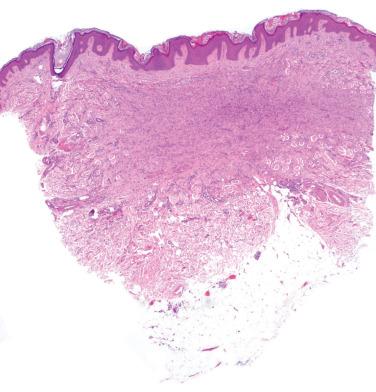
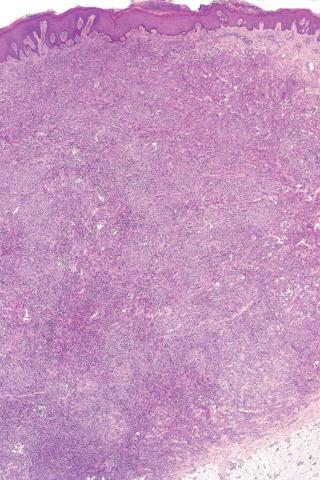
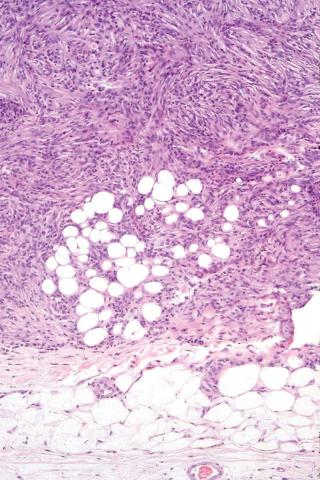
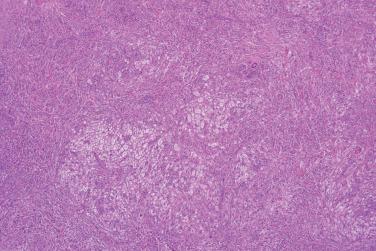
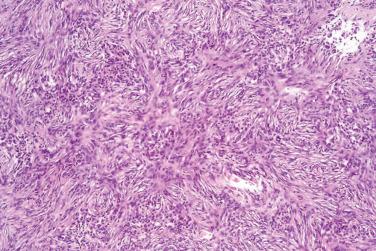
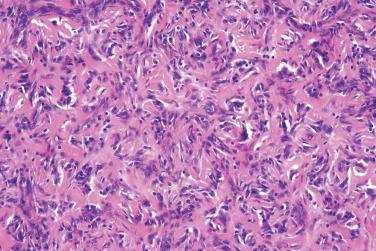
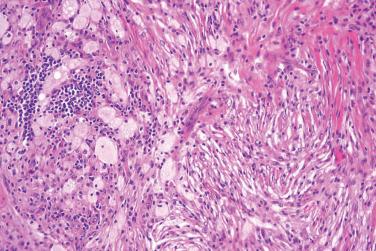
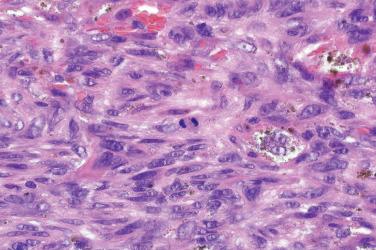
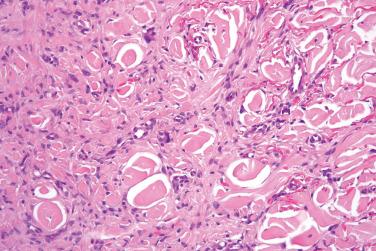
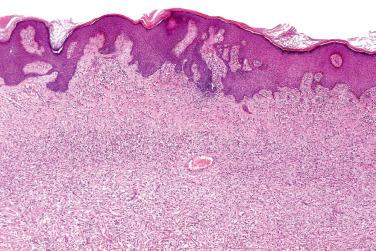
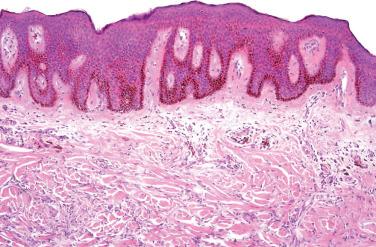
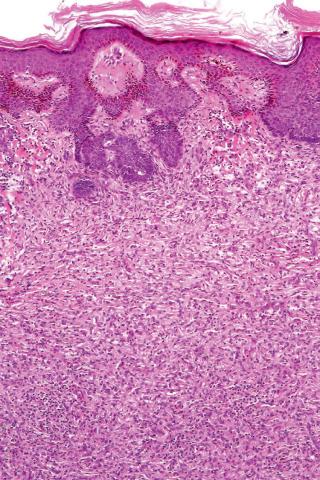
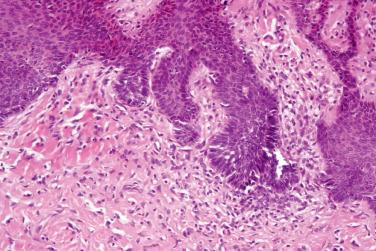
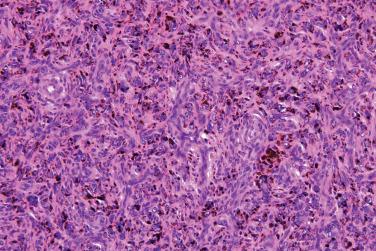
Distinctive variant of a benign fibrous histiocytoma (dermatofibroma), characterized by highly cellular monomorphic proliferation of spindle cells growing in a more fascicular and focally storiform pattern
Represents about 5% of benign fibrous histiocytomas
Approximately equal sex distribution, although slight male predominance observed in the initial publication
Wide age range, but most common in young to middle-aged adults (between 33 and 42 years)
Solitary asymptomatic nodule
Multifocal growth and familial occurrence in a single patient
Preoperative duration of the lesion variable (2 weeks to 2 years)
Upper limb/limb girdle followed by lower limb/limb girdle, head and neck, and trunk
Propensity for unusual sites, like face, ears, hands, and feet
Complete excision usually curative
Recurrence rate as high as 26% after incomplete/marginal excision
Locoregional (lymph nodes) and systemic metastases (lungs) in exceptional cases; no histological features have been detected to predict metastatic potential
Twο growth patterns recognized on low-power examination
Nonexophytic and ill defined (more common)
Exophytic and circumscribed
Defining features include
Cellular proliferation of plump spindle cells with tapering nuclei containing small eosinophilic nucleoli and relatively abundant ill-defined, pale eosinophilic cytoplasm
Short fascicular growth predominates over storiform growth pattern
Foci of more epithelioid cells occasionally present and represent a minor component of the lesion
Normal mitoses common (up to 10 mitoses per 10 high-power fields)
Abnormal mitoses not present
Focal necrosis (in up to 12%), generally not associated with surface ulceration
Surface ulceration uncommon
Most frequently arise in superficial dermis and subsequently infiltrate the deep dermis, but mid dermal and deep dermal origin not uncommon
Extension into the subcutis present in roughly one-third of the cases
Fascicular growth along the septa (perpendicular to the epidermis)
Lacelike growth between the fat cells
Infiltration beyond subcutis into the underlying skeletal muscle rare, usually in the head and neck area, most likely due to the more superficial localization of skeletal muscles at this particular site
Areas of a classical benign fibrous histiocytoma consistently identified at least focally, usually at the periphery of the cellular proliferation
Smooth muscle actin–positivity in over 90%
Cytoplasmic desmin positivity in 32%
Consistent with myofibroblastic differentiation
Genuine CD34 positivity in 6%
Usually seen at the periphery of the lesion or in a patchy pattern
Diffuse CD34 staining is an exception
Consistently negative for cytokeratins, S100 protein, and EMA
Factor XIIIa reveals nonneoplastic cells in the background
Atypical dermal smooth muscle tumor
Dermatofibrosarcoma protuberans
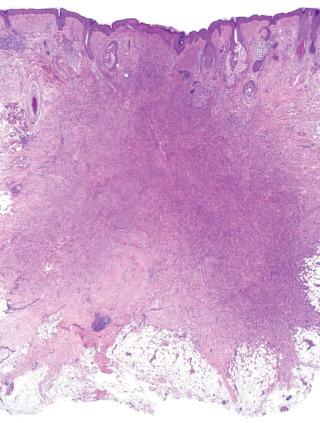
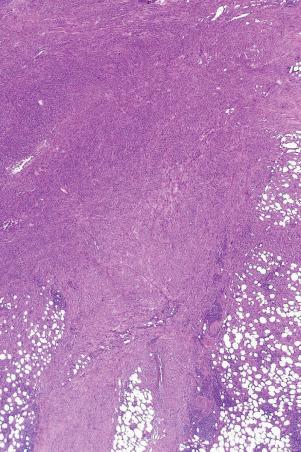
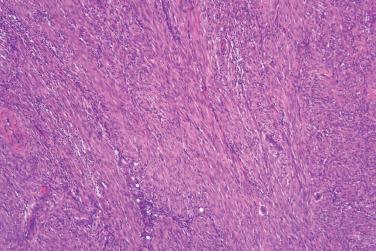
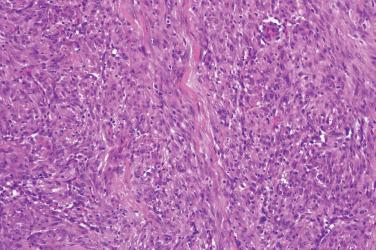
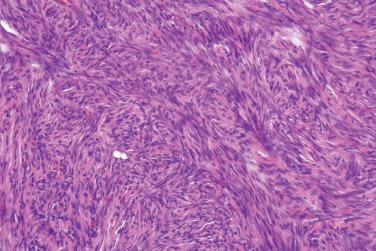

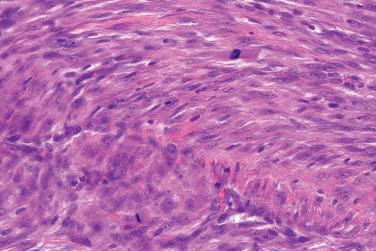
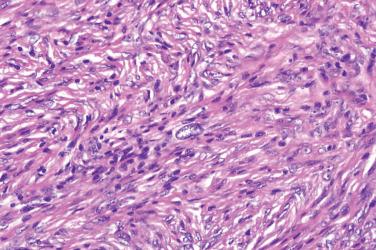
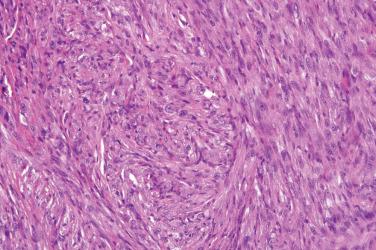
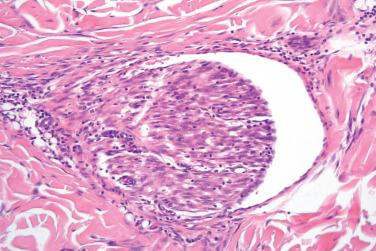
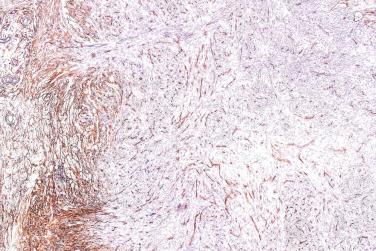
Distinctive variant of a benign fibrous histiocytoma (dermatofibroma), characterized by formation of variably sized, blood-filled spaces developing in the background of an ordinary common benign fibrous histiocytoma
Represents less than 2% of fibrous histiocytomas
Develops most frequently in the fourth decade of life (mean age 37 years)
Shows female predominance, with male-to-female ratio of 1 : 1.5
Broad anatomical distribution with predilection for the lower limbs/limb girdle (55%), followed by upper limbs/limb girdle (17%), trunk (12%), and head and neck (4%)
Solitary papule of variegated color from dark brown to red or blue
Diameter of the lesion from 5 to 40 mm
Multiple lesions develop exceptionally
Rapid growth due to hemorrhage within the preexistent long-standing lesion is a common presenting symptom
Simple excision is usually curative
Recurrences after incomplete/marginal excision are common (up to 20%)
Metastatic disease exceptional; no histological features have been detected to predict metastatic potential
Epidermis overlying the lesion demonstrates variable degrees of acanthosis
Generally located in the dermis; extension into the subcutis not uncommon, but infiltration into the underlying skeletal muscle rare
The lesion can be ill defined
Defining features include blood-filled spaces ranging from slitlike to large cavities, similar to cavernous hemangioma
Blood-filled spaces
Lack of endothelial lining
Are lined by the lesional cells, including histiocytes, fibroblasts, and giant cells
Are most frequently located within the most cellular parts of the lesion, usually central, which are devoid of collagen and elastic fibers
Can represent the predominant component of the lesion
Surrounding stroma contains numerous small capillaries, prominent interstitial hemorrhage, and hemosiderin deposition
Classical histological features of benign fibrous histiocytoma can usually be recognized at the periphery of the lesion
Lesional cells can stain focally for smooth muscle actin
Factor XIIIa–positive and CD34-positive cells may represent reactive cells within the lesion
Lesional cells are consistently negative for desmin, CD34, CD31, CD68, and factor XIIIa
Angiomatoid fibrous histiocytoma
Spindle cell hemangioma
Nodular Kaposi sarcoma
Angiosarcoma
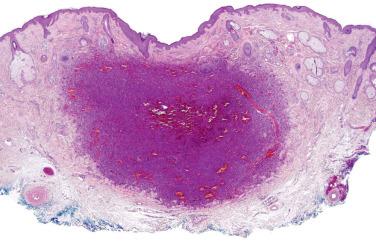
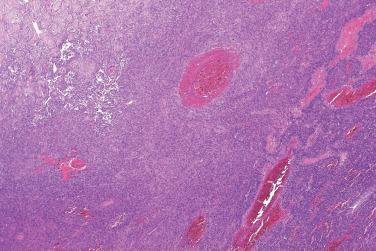
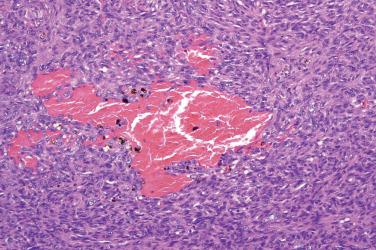
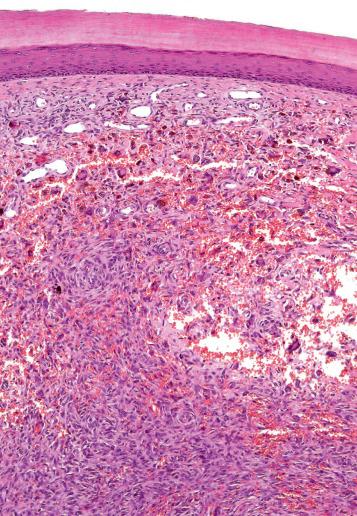
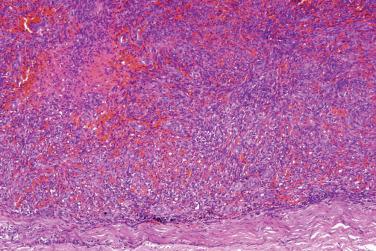
Although currently regarded as a variant of benign fibrous histiocytoma (dermatofibroma), it likely represents a distinctive and unrelated tumor type
Characterized histologically by proliferation of rounded or epithelioid cells comprising at least 50% of the lesional cell population
Typically displays cytoplasmic ALK positivity on immunohistochemistry and ALK gene rearrangements by fluorescence in situ hybridization (FISH)
Most frequent in the fifth decade of life
Slight male predominance with M:F ratio of 1.4 : 1
Solitary lesion, multicentric growth exceptional
Slightly raised or polypoid, symmetrical
Reddish papule/nodule of 5 to 20 mm in diameter
Most frequent sites of origin are lower extremities (60%), followed by upper extremities (20%), trunk (10%), and head and neck (less than 10%)
Simple excision is curative
Nondestructive recurrences after incomplete excision are rare
Two patterns at low-power magnification
Well-demarcated exophytic proliferation in the papillary and superficial reticular dermis (more common)
Less circumscribed and frequently more cellular proliferation extending into deep dermis but also into the superficial fatty tissue
Epidermal collarette frequently surrounds the lesion and can extend along its base
Epidermis above the lesion hyperplastic, atrophic, or both
Tumor-free zone between the epidermis and dermis, typical of common fibrous histiocytoma, is generally lacking
Rounded or polygonal epithelioid cells with abundant eosinophilic cytoplasm containing round-to-oval vesicular nuclei with small eosinophilic nucleoli should represent at least 50% of the lesional cells
Mild nuclear pleomorphism
Variable proportions of binucleated or trinucleated cells scattered among epithelioid cells; multinucleated giant cells, however, are rare
Occasional regular mitoses (average 1 per 10 high-power fields)
Numerous small blood vessels dispersed among epithelioid cells are a constant feature. They can form a predominant component of the proliferation, thus mimicking a vascular lesion
Delicate collagenous stroma, hyalinized in older lesions
Myxoid change can be prominent and can even predominate
Adnexal structures usually not seen within the lesion
Typical histological features of benign fibrous histiocytoma are usually seen at least focally
Admixture of factor XIIIa–positive dendritic histiocytes and CD34-positive dermal fibroblasts
EMA positivity can be present in roughly two-thirds of cases and D2-40 positivity in about 50%
Consistently negative for low- and high-molecular-weight cytokeratins, S100 protein, smooth muscle actin, desmin, and CD31
ALK expression (usually cytoplasmic) reported in most cases
ALK rearrangements are present in most cases
PRKCA, PRKCB, and PRCKD rearrangements are seen in a subset of other benign fibrous histiocytoma subtypes
Clonality detected in a limited number of cases
Spitz nevus
Reticulohistiocytoma
Juvenile xanthogranuloma
Epithelioid perineurioma
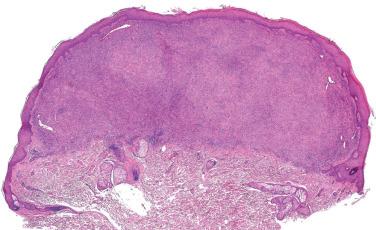
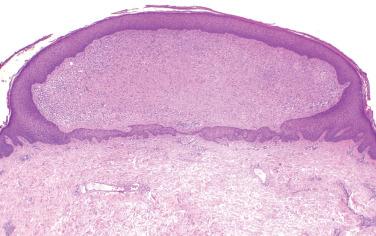
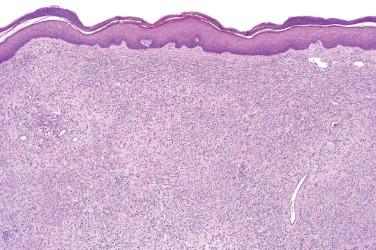
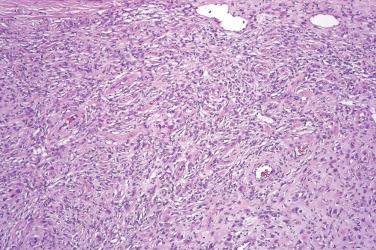
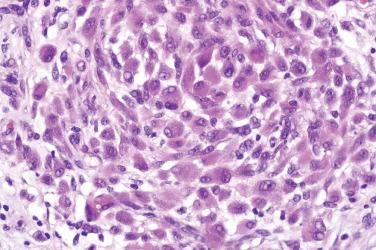

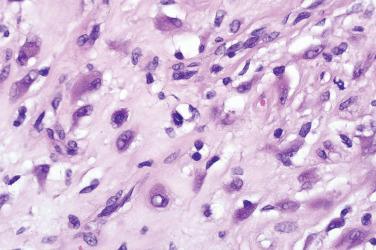
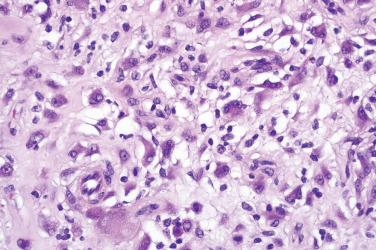
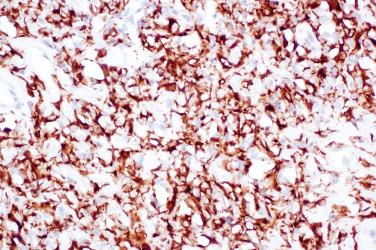
A rare variant of benign fibrous histiocytoma, characterized by proliferation of variably pleomorphic spindle and epithelioid cells in the background of an ordinary benign fibrous histiocytoma
Associated with increased tendency for local recurrences as well as slight potential for local and distant metastases
Similar lesions also designated dermatofibroma with monster cells, but the term atypical “pseudosarcomatous” fibrous histiocytoma preferable
Most frequently occurs in young to middle-aged adults in the fourth to fifth decade of life (mean age about 40 years)
Roughly equal gender distribution
Solitary non-painful nodule most common, polypoid lesion or a slightly raised plaque much rarer
Size of 4 to 80 mm in largest diameter (median 1.5 cm)
Lower limb/girdle (44%), followed by upper limb/girdle (32%), and trunk (11%), few cases in the head and neck area and genital region
Complete excision usually curative
Incomplete/marginal excision associated with recurrences in up to 14%
Two patients from the largest series developed distant metastases, one of whom died due to metastatic disease
No histological features have been detected to predict metastatic potential
Pleomorphic cells represent the hallmark of the lesion
Spindle (fibroblast-like) and polygonal/epithelioid (histiocyte-like) pleomorphic cells in variable proportions, admixed with multinucleated giant cells
Nuclei are irregular, large, hyperchromatic; bizarre-shaped forms not uncommon
Nucleoli prominent
Cytoplasm abundant, eosinophilic with indistinct borders, occasionally contains hemosiderin
Frequent regular mitoses (1–15 per 10 high-power fields [HPF], mean 3.4 per 10 HPF), atypical forms can also be observed
Pleomorphism varies from mild to moderate to severe and can be focal or diffuse
Geographical necrosis, usually found in lesions with moderate/marked degree of pleomorphism
Large areas of central collagen degeneration, surrounded by lesional cells, reminiscent of necrobiotic granuloma
Mainly localized in the dermis, but focal and superficial extension in the subcutis present in about one-third of the cases
Background proliferation
Ordinary fibrous histiocytoma in 100% of the cases
Proliferation of spindle cells and histiocyte-like cells in a vague storiform pattern with collagen trapping
Usually found at the periphery of pleomorphic component
Represents an important clue for correct recognition of the proliferation
Aneurysmal fibrous histiocytoma in roughly 25% of the cases
Epidermis can be hyperplastic with elongated rete ridges pattern
Focal positivity for smooth muscle actin and CD34 in limited number of cases
Consistently negative for S100 protein, low- and high-molecular-weight cytokeratins, desmin, CD68, and EMA
Pleomorphic fibroma
Dermatofibrosarcoma protuberans
Atypical fibroxanthoma
Spindle cell squamous cell carcinoma
Melanoma
Atypical intradermal smooth muscle neoplasm
Leiomyosarcoma
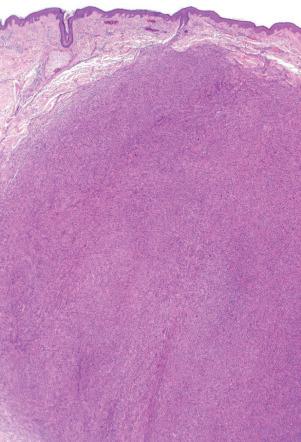
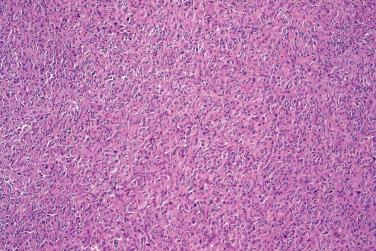
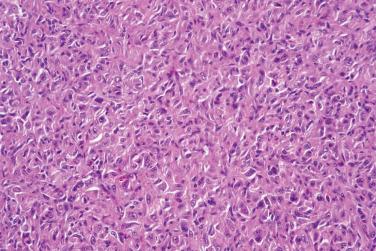
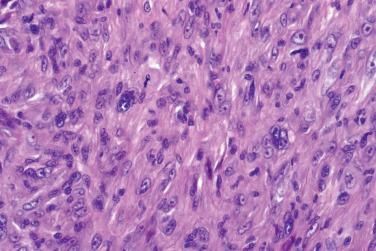
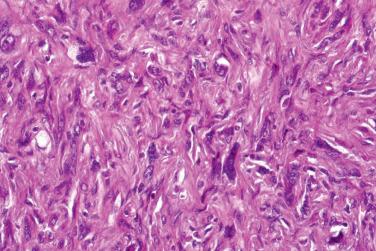
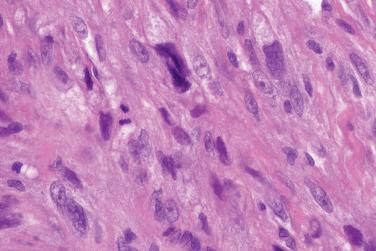
A distinctive variant of benign fibrous histiocytoma characterized by the predominance of lipidized (foamy) histiocytes
Similar age distribution as a common benign fibrous histiocytoma (median age about 50 years)
Male predominance (M:F = 2.7 : 1)
Solitary polypoid, yellow papule or nodule
Initial study demonstrated predilection for lower extremities, particularly around the ankle, hence connotation “ankle-type”; however, subsequent study demonstrated similar site distribution to classical fibrous histiocytoma
Larger size than classical fibrous histiocytoma (median size 2.5 cm)
Not associated with elevated serum lipid levels
Become a Clinical Tree membership for Full access and enjoy Unlimited articles
If you are a member. Log in here